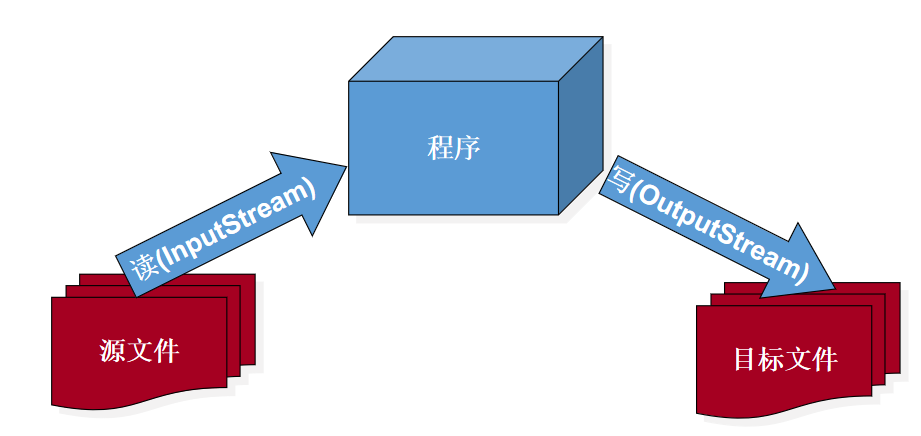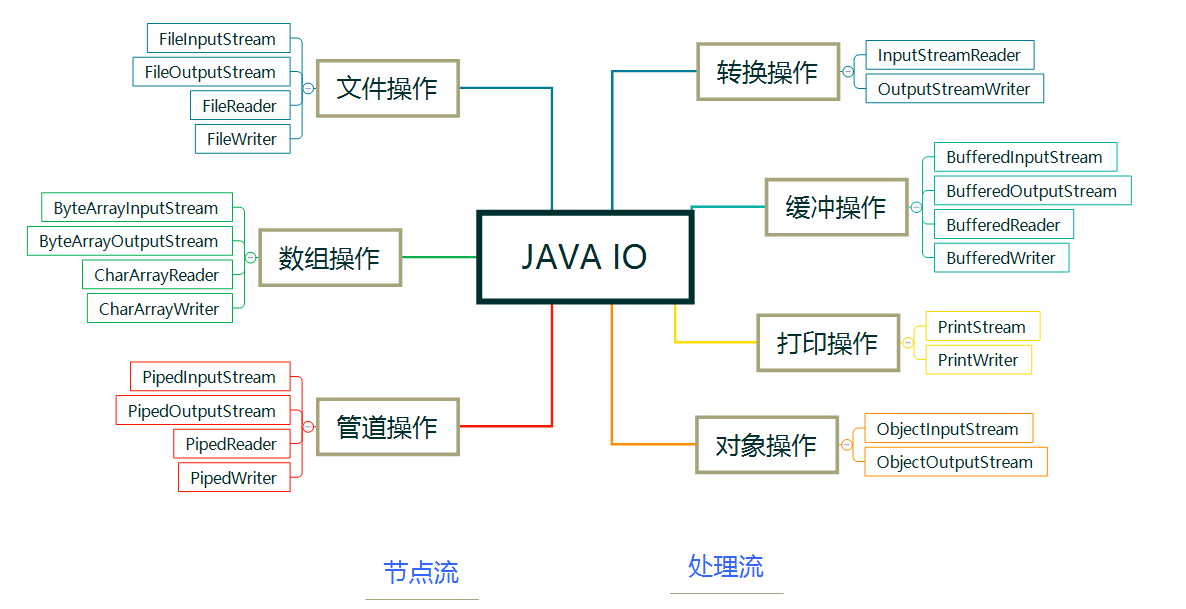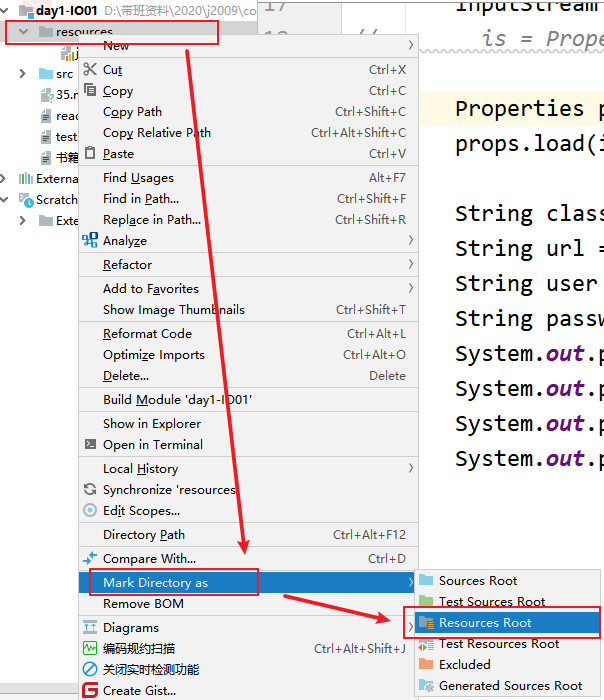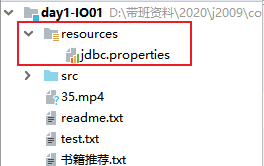01 - IO(一) ✒️
流概述
什么是流(IO)
流(Stream),是一种抽象的概念,比如:现实生活中的的:水流,河流等;指的是一种物质(数据)从一个位置以一种特殊的方式,转移到另一个位置的过程,那么这种特殊的转移方式称之为流;流在计算中以 IO(Input/Output)的形式存在,即输入(耳朵)与输出(嘴巴),比如通过程序将数据写入文件的过程称之为输出,将文件中的数据读取到程序中的过程称之为输入
输入输出目标:
- 文件
- 网络
JavaIO 中的所有类都是位于
java.io包
流向说明
java 中的流向指的是输入与输出,并且这个概念是站在程序的角度考虑。

流的分类
分类
流根据不同的分类方式分为以下几类:
- 按流向分:输入流与输出流
- 按传输的数据类型分:字节流和字符流
- 按照处理能力分为:节点流与处理流(包装流)
java 中大多数以 Stream 结尾的流都是字节流,大多数以 Reader 或 Writer 结尾的流都是字符流
体系结构

顶级父类
java 中所有的流的顶级父类都从以下几个父类继承,以下这些所有的都是抽象类(abstrtact)

字节流与字符流
字节流
所谓字节流,即数据的传输方式以字节为单位进行,字节流的读取方式为每次以一个字节进行传输,一般字节流相对比较通用的一种流,比如常见二进制文件(图片,视频,音频)的操作都可以通过字节流完成。
字节流的顶级父类主要包含:
- InputStream:字节输入流
- OutputStream:字节输出流
InputStream
字节输入流,是一个抽象类,其中常见的子类主要有:
- FileInputStream
- BufferedInputStream
- ByteArrayInputStream
- ObjectInputStream
InputStream 常见方法:
- available():获取流中的可读字节数
- read():读取一个字节的数据,并返回(如果流中没有可读字节内容则返回-1)
- read(byte[] b):将输入的字节内容存储到字节缓冲区(b)中,并返回实际的读取长度
- skip(int i):跳过指定个字节发生下一次读取
- close():关闭程序与系统资源之间的通道
基本案例:
File file = new File("C:\\Users\\Administrator\\Desktop\\test.txt");
InputStream is = new FileInputStream(file);
byte[] bytes = new byte[is.available()]; //0 0.0 false ' ' null
//跳过指定个字节读取
is.skip(5);
//将流中的数据读取到字节数组中
is.read(bytes);
//将字节数组转换为字符串
String s = new String(bytes);
System.out.println(s);
//关闭资源
is.close();
OutputStream
字节输出流基类,所有的的字节输出流都是从该类继承,OutputStream 是一个抽象类,常见子类有:
- FileOutputStream
- BufferedOutputStream
- ByteArrayOutputStream
- ObjectOutputStream
OutputStream 常见方法
- write(int b):向指定输出源输出一个字节
- write(byte[] b):向指定输出源输出字节数组
- write(byte[] b,int offset,int len):向指定输出源输出字节数组,并且偏移 offset 个字节,写入 len 长度个字节
- close():关闭程序与系统资源之间的连接通道
使用案例:
public class OutputDemo1 {
public static void main(String[] args) throws IOException {
File file = new File("day1-IO01/readme.txt");
//创建文件的输出流,使用追加模式(在文件末尾发生写入操作)
OutputStream os = new FileOutputStream(file,true);
//向输入流中写入一个字节
// os.write(97);
String str = "宝剑锋自磨砺出,梅花香自苦寒来";
os.write(str.getBytes(Charset.forName("gbk")));
os.close();
}
}
字符流
所谓字节流,即数据的传输方式以字符为单位进行,数据的传输为每次传输一个字符(即两个字节),因此比较适合与传输文本信息,但是不适用与传输二进制文件数据,会导致文件格式破坏从而无法正常打开。另外一种常见的字符流使用为字符格式转码(例如:UTF-8 转 GBK)
JavaIO 中的字符流都从以下两个抽象类继承而来:
- Reader:字符输入流
- Writer:字符输出流
Reader
Reader 用于使用字符的形式从输入源(文件或网络)中读取字符内容,读取方式是一个一个字符读取,常见方法类似 InputStream:
- read():读取一个字符
- read(char[] ch):将读取的字符存储到字符缓冲区,返回真实读取字符数,读取到末尾时返回-1
- read(char[] ch,int offset,int len):将读取的字符存储到字符缓冲区,偏移 offset 位读取,读取 len 为位
- skip(long l):跳过指定个字符发生下一次读取
Reader 常见的子类:
- FileReader
- InputStreamReader
- BufferedReader
基本案例:
File file = new File("D:\\文档资料\\电子书\\书籍推荐.txt");
//根据提供的文件构建一个字符文件输入流
FileReader reader = new FileReader(file);
String encoding = reader.getEncoding();
System.out.println("字符编码:"+encoding);
int i = -1;
while((i = reader.read()) != -1){
System.out.print((char)i);
}
以上的读取方式,从底层来看,效率比较低,因为循环的时候是每次读取一个字符,因此循环的次数较多,必然会增加时间上的开销。若需要提高读取效率,则可以考虑使用空间换取时间的方式,使用字符缓冲区:
File file = new File("D:\\文档资料\\电子书\\书籍推荐.txt"); //根据提供的文件构建一个字符文件输入流 FileReader reader = new FileReader(file); String encoding = reader.getEncoding(); System.out.println("字符编码:"+encoding); char[] c = new char[512]; int len = 0; while((len = reader.read(c)) != -1){ String s = new String(c,0,len); System.out.println(s); }
Writer
Writer 用于以字符的形式将文本内容输出到指定的输出源,常见方法:
- write(int b)
- write(char[] c)
- write(char[] c,int offset,int len)
- write(String s)
- flush()
基本案例:
File file = new File("day1-IO01/test.txt");
FileWriter fw = new FileWriter(file, true);
fw.write("床前明月光,汗滴禾下土");
fw.close();
使用字符流实现文件拷贝:
在 GBK 的编码模式下 1 个中文字符等于 2 个字节;
在 UTF-8 的编码模式下 1 个中文字符等于 3 个字节;
字节流字符流的区别:
两种流分别采用的不同形式读取文件,在进行二进制文件读取时适合使用字节流,而对文本文件读取时适合使用字符流
流案例之文件拷贝
所谓文件拷贝,即将一个文件从一个指定的目录复制到另一个目录的过程,原理:对源文件使用输入流读取,将读取的字节缓存到程序的内存中,然后再获取目标文件的输出流,将缓存的字节通过输出流写出到指定位置
实现代码:
/**
* @Author mrchai 2021/1/11 11:32
*/
public class FileCopy {
/**
* 将一个源文件拷贝到目标目录中
* @param source 源文件
* @param dir 目标目录
*/
public static void copy(File source, File dir) throws IOException {
//获取源文件的输出流
try(
FileInputStream fis = new FileInputStream(source);
//获取目标文件的输出流
FileOutputStream fos = new FileOutputStream(new File(dir,source.getName()));
) {
//声明字节缓冲区
byte[] b = new byte[1024];
int len = 0;
System.out.println("开始拷贝...");
while ((len = fis.read(b)) != -1) {
fos.write(b, 0, len);
}
System.out.println("拷贝完成!");
}
}
public static void main(String[] args) throws IOException {
File source = new File("day1-IO01/35.mp4");
File dir = new File("C:\\Users\\Administrator\\Desktop");
copy(source,dir);
//思考:如何实现目录拷贝(目录中还可能包含子目录)
}
}
资源文件读取与 Properties 类
读取 resources 目录下的资源

java 项目中的资源文件或配置文件(比如:xml 文件,properties 文件)一般会存放在 resources 目录下,该目录在 maven 项目中自动包含,如果是非 maven 项目,需要手动创建目录,并将目录设置为Resource Root,参考以上操作,操作完成后,目录显示效果如下:

在程序中对资源文件的读取方式如下:
//读取资源为InputStream
//方式一:
InputStream is1 = PropertiesDemo.class.getResourceAsStream("/jdbc.properties");
//方式二:
InputStream is2 = PropertiesDemo.class.getClassLoader().getResourceAsStream("jdbc.properties");
//读取资源为URL
//方式一:
URL url1 = PropertiesDemo.class.getResource("/jdbc.properties");
//方式二:
URL url2 = PropertiesDemo.class.getClassLoader().getResource("jdbc.properties");
Properties 类
Properties 是从 Hashtable 继承而来,存储的结构为键值对的属性信息,通过加载输入流(字节,字符)将流中的数据读取为属性列表(键值对对结构);
属性文件的结构:
jdbc.properties:
driverClass=com.mysql.jdbc.Driver
url=jdbc:mysql://127.0.0.1:3306/test
user=root
password=123456
读取属性文件内容:
//加载指定资源文件成为流
InputStream is = PropertiesDemo.class.getResourceAsStream("/jdbc.properties");
//创建Properties对象
Properties props = new Properties();
//将流数据装载Properties对象中
props.load(is);
//根据属性的键获取值
String className = props.getProperty("driverClass");
String url = props.getProperty("url");
String user = props.getProperty("user");
String password = props.getProperty("password");
System.out.println(className);
System.out.println(url);
System.out.println(user);
System.out.println(password);
处理流与打印流
之前所了解的流都是直接与输入输出源对接的流,这些流称之节点流(低级流);因此在 IO 的体系结构中,另外还存在一些用于对其他流进行处理的高级流,也称之处理流(包装流),比如流类型的转换会使用转换流,提高读写效率时使用缓冲流,进行打印输出操作时使用打印流等。高级流实际是基于一种设计模式所实现(装饰器模式);处理流主要有以下几类:
- 转换流:用于字节流和字符流之间的转换
- InputStreamReader:将字节输入流转换为字符输入流(从字节通往字符的桥梁)
- OutputStreamWriter:将字符输出流转换为字节输出流(从字符通往字节的桥梁)
- 缓冲流
- BufferedInputStream
- BufferedOutputStream
- BufferedReader
- BufferedWriter
- 打印流
转换流基本使用
// InputStream is = System.in;
// //将字节流包装为字符流
// InputStreamReader isr = new InputStreamReader(is,"gbk");
// int i = -1;
// while((i = isr.read()) != -1){
// System.out.print((char)i);
// }
// isr.close();
//将字符输出流转换为字节输出流
OutputStreamWriter osw = new OutputStreamWriter(new FileOutputStream("day1-IO01/test.txt",true));
osw.write("鹅鹅鹅,曲项向天歌");
osw.close();
文件编码转换(主要针对文本文件)
public class CharacterConverterUtils {
public static void convert(File source, File dir, String oldEncoding, String newEncoding) throws IOException {
try(
//将源文件以字节流读取,并以指定的字符编码读取并转换为字符流
InputStreamReader isr = new InputStreamReader(new FileInputStream(source),oldEncoding);
//获取目标文件的输出流并以自定的字符编码写入
OutputStreamWriter osw = new OutputStreamWriter(new FileOutputStream(new File(dir,source.getName())),newEncoding);
) {
char[] c = new char[512];
int len = 0;
System.out.println("开始转换...");
while ((len = isr.read(c)) != -1) {
osw.write(c, 0, len);
}
System.out.println("转换完成");
}
}
public static void main(String[] args) throws IOException {
File source = new File("C:\\Users\\Administrator\\Desktop\\gbk\\Config.java");
File dir = new File("C:\\Users\\Administrator\\Desktop\\utf8");
convert(source,dir,"gbk","utf-8");
}
}
缓冲流
缓冲流是 IO 包中提供的用于高效进行读写操作的流,流的内部实现包含了一个固定大小的缓冲区,缓冲流主要包含以下四个类:
- BufferedInputStream
- BufferedOutputStream
- BufferedReader
- BufferedWriter
BufferedInputStream 基本使用:
public static void main(String[] args) throws IOException {
File file = new File("day1-IO01/35.mp4");
BufferedInputStream bis = new BufferedInputStream(new FileInputStream(file));
long begin = System.currentTimeMillis();
byte[] b = new byte[1024];
int len = 0;
while((len = bis.read(b)) != -1){
}
long end = System.currentTimeMillis();
System.out.println("耗时:"+(end- begin));
bis.close();
}
BufferedReader 基本使用:
public class BufferedDemo2 {
public static void main(String[] args) throws IOException {
File file = new File("day1-IO01/书籍推荐.txt");
BufferedReader br = new BufferedReader(new FileReader(file));
String line = null;
while((line = br.readLine()) != null){
System.out.println(line);
}
br.close();
}
}